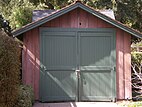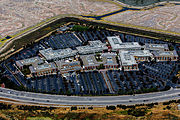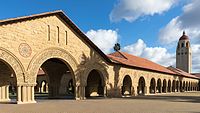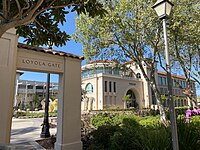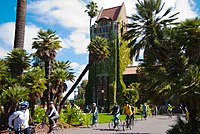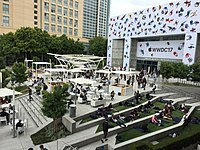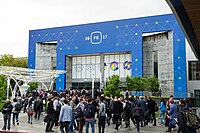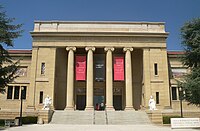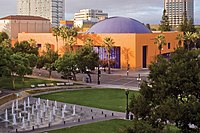Silicon Valley
Silicon Valley | |
|---|---|
Aerial view of Silicon Valley The now-demolished "Blue Cube" | |
| Coordinates: 37°22′39″N 122°04′03″W / 37.37750°N 122.06750°W | |
| Country | United States |
| State | California |
| Region | San Francisco Bay Area |
| Megaregion | Northern California |
| Time zone | UTC−8 (Pacific) |
| • Summer (DST) | UTC−7 (PDT) |
Silicon Valley is a region in Northern California that is a global center for high technology and innovation. Located in the southern part of the San Francisco Bay Area, it corresponds roughly to the geographical area of the Santa Clara Valley.[1][2][3] The term "Silicon Valley" refers to the area in which high-tech business has proliferated in Northern California, and it also serves as a general metonym for California's high-tech business sector.
The cities of Sunnyvale, Mountain View, Palo Alto and Menlo Park are frequently cited as the birthplace of Silicon Valley. San Jose is Silicon Valley's largest city, the third-largest in California, and the 13th-most populous in the United States.[4] Other major Silicon Valley cities include Santa Clara, Redwood City and Cupertino. The San Jose Metropolitan Area has the third-highest GDP per capita in the world (after Zürich, Switzerland and Oslo, Norway), according to the Brookings Institution.[5] As of June 2021, it also had the highest percentage of homes valued at $1 million or more in the United States.[6]
Silicon Valley is home to many of the world's largest high-tech corporations, including the headquarters of more than 30 businesses in the Fortune 1000, and thousands of startup companies. Silicon Valley also accounts for one-third of all of the venture capital investment in the United States, which has helped it to become a leading hub and startup ecosystem for high-tech innovation, although the tech ecosystem has recently become more geographically dispersed.[7][8] It was in Silicon Valley that the silicon-based integrated circuit, the microprocessor, and the microcomputer, among other technologies, were developed. As of 2021[update], the region employed about a half million information technology workers.[9]
As more high-tech companies were established across San Jose and the Santa Clara Valley, and then north towards the Bay Area's two other major cities, San Francisco and Oakland, the term "Silicon Valley" came to have two definitions: a narrower geographic one, referring to Santa Clara County and southeastern San Mateo County, and a metonymical definition referring to high-tech businesses in the entire Bay Area. The term Silicon Valley is often used as a synecdoche for the American high-technology economic sector. The name also became a global synonym for leading high-tech research and enterprises, and thus inspired similarly named locations, as well as research parks and technology centers with comparable structures all around the world. Many headquarters of tech companies in Silicon Valley have become hotspots for tourism.[10][11][12]

Etymology
[edit]"Silicon" refers to the chemical element used in silicon-based transistors and integrated circuit chips, which is the focus of a large number of computer hardware and software innovators and manufacturers in the region.
The popularization of the name is often credited to Don Hoefler, the first journalist to use the term in a news story.[1] His article "Silicon Valley U.S.A." was published in the January 11, 1971, issue of the weekly trade newspaper Electronic News. In preparation for this report, during a lunch meeting with marketing people who were visiting the area, he heard them use the term.[13] Earlier uses outside journalism exist; for example, a May 1970 advertisement in the Peninsula Times Tribune described a Palo Alto company that "helps production people in Silicon Valley."[14]
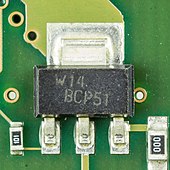
However, the term did not gain widespread use until the early 1980s,[1] at the time of the introduction of the IBM PC and numerous related hardware and software products to the consumer market.
The urbanized area is built upon an alluvial plain[15] within a longitudinal valley formed by roughly parallel earthquake faults. The area between the faults subsided into a graben or dropped valley.[16][17] Hoefler defined Silicon Valley as the urbanized parts of "the San Francisco Peninsula and Santa Clara Valley".[13] Before the expansive growth of the tech industry, the region had been the largest fruit-producing and packing region in the world up through the 1960s, with 39 fruit canneries.[18][19] The nickname it had been known as during that period was "the Valley of Heart’s Delight".[20][21]
History
[edit]Silicon Valley was born through the intersection of several contributing factors, including a skilled science research base housed in area universities, plentiful venture capital, permissive government regulation, and steady U.S. Department of Defense spending. Stanford University’s leadership was especially important in the valley's early development.[22] Together these elements formed the basis of its growth and success.[23] The United States was more friendly than other countries to business investment, charging much lower taxes on capital gains since the Revenue Act of 1921, and featuring particularly loose free market controls over new business. In 1953, the Small Business Administration was created to foster startups, giving a boost to entrepreneurs. Northern California was even more welcoming, with a group of venture capitalists actively seeking high-tech business ideas, clustered on Sand Hill Road in Menlo Park and Palo Alto. California's civil code undermined the usual non-compete clauses that effectively tied employees to their companies in other states, allowing California workers to freely apply the knowledge they gained from their previous employer. This gave Silicon Valley an advantage over other American tech hubs such as Massachusetts Route 128 curving around Boston.[24]
Early military origins
[edit]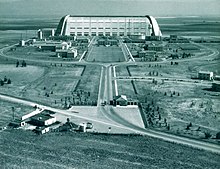
The San Francisco Bay Area had long been a major site of United States Navy research and technology. In 1909, Charles Herrold started the first radio station in the United States with regularly scheduled programming in San Jose. Later that year, Stanford University graduate Cyril Elwell purchased the U.S. patents for Poulsen arc radio transmission technology and founded the Federal Telegraph Corporation (FTC) in Palo Alto. Over the next decade, the FTC created the world's first global radio communication system, and signed a contract with the Navy in 1912.[25]
In 1933, Air Base Sunnyvale, California, was commissioned by the United States Government for use as a Naval Air Station (NAS) to house the airship USS Macon in Hangar One. The station was renamed NAS Moffett Field, and between 1933 and 1947, U.S. Navy blimps were based there.[26] A number of technology firms had set up shop in the area around Moffett Field to serve the Navy. When the Navy gave up its airship ambitions and moved most of its west coast operations to San Diego, the National Advisory Committee for Aeronautics (NACA, forerunner of NASA) took over portions of Moffett Field for aeronautics research. Many of the original companies stayed, while new ones moved in. The immediate area was soon filled with aerospace firms, such as Lockheed, which was the area's largest employer from the 1950s into 1980s.[27]
Role of Stanford University
[edit]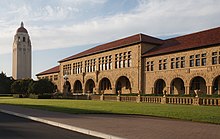
Stanford University, its affiliates, and graduates have played a major role in the development of the culture of collaboration among high-tech companies.[28] A powerful sense of regional solidarity shaped the outlook of inventors and engineers in California; contrasting markedly from the insular and competitive environment of engineering firms on the East Coast of the United States.[25][29] From the 1890s, Stanford University's leaders saw its mission as service to the (American) West and shaped the school accordingly. At the same time, the perceived exploitation of the West at the hands of eastern interests fueled booster-like attempts to build self-sufficient local industry. Thus regionalism helped align Stanford's interests with those of the area's high-tech firms.[30]
Frederick Terman, as Stanford University's dean of the school of engineering from 1946,[31] encouraged faculty and graduates to start their own companies. In 1951 Terman spearheaded the formation of Stanford Industrial Park (now Stanford Research Park, an area surrounding Page Mill Road, south west of El Camino Real and extending beyond Foothill Expressway to Arastradero Road), where the university leased portions of its land to high-tech firms.[32] Terman nurtured companies like Hewlett-Packard, Varian Associates, Eastman Kodak, General Electric, Lockheed Corporation, and other high-tech firms, until what would become Silicon Valley grew up around the Stanford University campus.
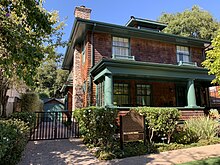
In 1951, to address the financial demands of Stanford's growth requirements, and to provide local employment-opportunities for graduating students, Frederick Terman proposed leasing Stanford's lands for use as an office park named the Stanford Industrial Park (later Stanford Research Park). Terman invited only high-technology companies. The first tenant was Varian Associates, founded by Stanford alumni in the 1930s to build military-radar components. Terman also found venture capital for civilian-technology start-ups. Hewlett-Packard became one of the major success-stories. Founded in 1939 in Packard's garage by Stanford graduates Bill Hewlett and David Packard, Hewlett-Packard moved its offices into the Stanford Research Park shortly after 1953. In 1954 Stanford originated the Honors Cooperative Program to allow full-time employees of the companies to pursue graduate degrees from the university on a part-time basis. The initial companies signed five-year agreements in which they would pay double the tuition for each student in order to cover the costs. Hewlett-Packard has become the largest personal-computer manufacturer in the world, and transformed the home-printing market when it released the first thermal drop-on-demand ink-jet printer in 1984.[33] Other early tenants included Eastman Kodak, General Electric, and Lockheed.[34]
Rise of Silicon
[edit]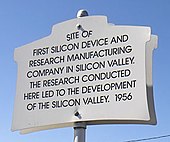
In 1956, William Shockley, the co-inventor of the first working transistor (with John Bardeen and Walter Houser Brattain), moved from New Jersey to Mountain View, California, to start Shockley Semiconductor Laboratory to live closer to his ailing mother in Palo Alto. Shockley's work served as the basis for many electronic developments for decades.[35][36] Both Frederick Terman and William Shockley are often called "the father of Silicon Valley".[37][38] Unlike many other researchers who used germanium as the semiconductor material, Shockley believed that silicon was the better material for making transistors. Shockley intended to replace the current transistor with a new three-element design (today known as the Shockley diode), but the design was considerably more difficult to build than the "simple" transistor. In 1957, Shockley decided to end research on the silicon transistor. As a result of Shockley's abusive management style, eight engineers left the company to form Fairchild Semiconductor; Shockley referred to them as the "traitorous eight". Two of the original employees of Fairchild Semiconductor, Robert Noyce and Gordon Moore, would go on to found Intel.[39][40]
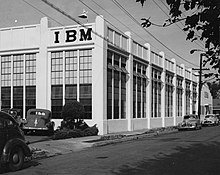
Following the 1959 inventions of the monolithic integrated circuit (IC) chip by Robert Noyce at Fairchild, the first commercial MOS IC was introduced by General Microelectronics in 1964.[41] The first single-chip microprocessor was the Intel 4004,[42] designed and realized by Federico Faggin along with Ted Hoff, Masatoshi Shima and Stanley Mazor at Intel in 1971.[43][44] In April 1974, Intel released the Intel 8080, the second 8-bit microprocessor designed and manufactured by Intel.[45]
Origins of the Internet
[edit]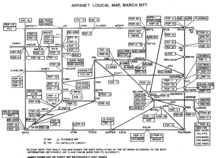
On April 23, 1963, J. C. R. Licklider, the first director of the Information Processing Techniques Office (IPTO) at The Pentagon's ARPA issued an office memorandum addressed to Members and Affiliates of the Intergalactic Computer Network. It rescheduled a meeting in Palo Alto regarding his vision of a computer network, which he imagined as an electronic commons open to all, the main and essential medium of informational interaction for governments, institutions, corporations, and individuals.[46][47][48][49] As head of IPTO from 1962 to 1964, "Licklider initiated three of the most important developments in information technology: the creation of computer science departments at several major universities, time-sharing, and networking."[49] In 1969, the Stanford Research Institute (now SRI International), operated one of the four original nodes that comprised ARPANET, predecessor to the Internet.[50]
Emergence of venture capital
[edit]By the early 1970s, there were many semiconductor companies in the area, computer firms using their devices, and programming and service companies serving both. Industrial space was plentiful and housing was still inexpensive. Growth during this era was fueled by the emergence of venture capital on Sand Hill Road, beginning with Kleiner Perkins and Sequoia Capital in 1972; the availability of venture capital exploded after the successful $1.3 billion IPO of Apple Computer in December 1980. Since the 1980s, Silicon Valley has been home to the largest concentration of venture capital firms in the world.[51]
In 1971, Don Hoefler traced the origins of Silicon Valley firms, including via investments from Fairchild's eight co-founders.[13][52] The key investors in Kleiner Perkins and Sequoia Capital were from the same group, directly leading to Tech Crunch 2014 estimate of 92 public firms of 130 related listed firms then worth over US$2.1 trillion with over 2,000 firms traced back to them.[53]
Banking
[edit]Another important pillar of the Valley's success was Silicon Valley Bank (SVB), founded in 1983 by a group of former Bank of America executives.[51] Before its 2023 collapse, SVB specialized in providing banking services to Silicon Valley entrepreneurs and their startup firms. SVB's original primary commercial lending product was a working capital line of credit, secured by a startup's accounts receivable.[54] In contrast to traditional banks, who focused their commercial lending on already-established businesses, SVB specialized in lending money to small startup companies in the "preprofit" stage.[54]
Lawyers and law firms
[edit]Prior to 1970, most Northern California lawyers were based in San Francisco, especially the experienced patent attorneys whom the high-tech industry needed to protect its intellectual property. During the 1970s, lawyers began to follow venture capitalists down the Peninsula to serve the booming high-tech industry in Silicon Valley.[55] As of 1999, there were 2,400 lawyers practicing law in Palo Alto, a city of only 50,000 people, "the densest concentration of lawyers" in the United States outside of Washington, D.C.[56]
By the year 2000, large law firms from all over the world were rushing to establish offices in the mid-Peninsula region on or near Sand Hill Road, and Silicon Valley law firms had become global trendsetters in that they were the first legal services employers to adopt business casual apparel (in imitation of their startup clients).[57] During this era, lawyers evolved from their relatively narrow conventional role as protectors of intellectual property into business advisers, intermediaries, and dealmakers, and thereby acquired great prominence in Silicon Valley.[57][58] For young entrepreneurs new to the Valley's mysterious ways, their lawyer often served as their first coach, mentor, teacher, friend, and cheerleader who helped connect them to the Valley's startup ecosystem.[59] As of 2022, the San Jose-Sunnyvale-Santa Clara metropolitan area had the highest average wage for lawyers in the United States, at $267,840.[60]
Rise of computer culture
[edit]
The Homebrew Computer Club was an informal group of electronic enthusiasts and technically minded hobbyists who gathered to trade parts, circuits, and information pertaining to DIY construction of computing devices.[61] It was started by Gordon French and Fred Moore who met at the Community Computer Center in Menlo Park. They both were interested in maintaining a regular, open forum for people to get together to work on making computers more accessible to everyone.[62]
The first meeting was held as of March 1975 at French's garage in Menlo Park, San Mateo County, California; which was on occasion of the arrival of the MITS Altair microcomputer, the first unit sent to the area for review by People's Computer Company. Steve Wozniak and Steve Jobs credit that first meeting with inspiring them to design the original Apple I and (successor) Apple II computers. As a result, the first preview of the Apple I was given at the Homebrew Computer Club.[63] Subsequent meetings were held at an auditorium at the Stanford Linear Accelerator Center.[64]
Advent of software
[edit]Although semiconductors are still a major component of the area's economy, Silicon Valley has been most famous in recent years for innovations in software and Internet services. Silicon Valley has significantly influenced computer operating systems, software, and user interfaces. Using money from NASA, the US Air Force, and ARPA, Douglas Engelbart invented the mouse and hypertext-based collaboration tools in the mid-1960s and 1970s while at Stanford Research Institute (now SRI International), first publicly demonstrated in 1968 in what is now known as The Mother of All Demos.
Engelbart's Augmentation Research Center at SRI was also involved in launching the ARPANET (precursor to the Internet) and starting the Network Information Center (now InterNIC). Xerox hired some of Engelbart's best researchers beginning in the early 1970s. In turn, in the 1970s and 1980s, Xerox's Palo Alto Research Center (PARC) played a pivotal role in object-oriented programming, graphical user interfaces (GUIs), Ethernet, PostScript, and laser printers.
While Xerox marketed equipment using its technologies, for the most part its technologies flourished elsewhere. The diaspora of Xerox inventions led directly to 3Com and Adobe Systems, and indirectly to Cisco, Apple Computer, and Microsoft. Apple's Macintosh GUI was largely a result of Steve Jobs' visit to PARC and the subsequent hiring of key personnel.[65] Cisco's impetus stemmed from the need to route a variety of protocols over Stanford University's Ethernet campus network.[66]
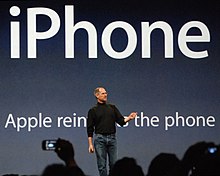
Internet age
[edit]Commercial use of the Internet became practical and grew slowly throughout the early 1990s. In 1995, commercial use of the Internet grew substantially and the initial wave of internet startups, Amazon.com, eBay, and the predecessor to Craigslist began operations.[67] Silicon Valley is generally considered to have been the center of the dot-com bubble, which started in the mid-1990s and collapsed after the NASDAQ stock market began to decline dramatically in April 2000. During the bubble era, real estate prices reached unprecedented levels. For a brief time, Sand Hill Road was home to the most expensive commercial real estate in the world, and the booming economy resulted in severe traffic congestion.
The PayPal Mafia is sometimes credited with inspiring the re-emergence of consumer-focused Internet companies after the dot-com bust of 2001.[68] After the dot-com crash, Silicon Valley continues to maintain its status as one of the top research and development centers in the world. A 2006 The Wall Street Journal story found that 12 of the 20 most inventive towns in America were in California, and 10 of those were in Silicon Valley.[69] San Jose led the list with 3,867 utility patents filed in 2005, and number two was Sunnyvale, at 1,881 utility patents.[70] Silicon Valley is also home to a significant number of "Unicorn" ventures, referring to startup companies whose valuation has exceeded $1 billion dollars.[71]
Economy
[edit]A world-renowned technology hub, San Francisco Bay Area has the largest concentration of high-tech companies in the United States, at 387,000 high-tech jobs, of which Silicon Valley accounts for 225,300 high-tech jobs.[72][73][74] Silicon Valley has the highest concentration of high-tech workers of any metropolitan area, with 285.9 out of every 1,000 private-sector workers. Silicon Valley has the highest average high-tech salary in the United States at $144,800.[75] Largely a result of the high technology sector, the San Jose-Sunnyvale-Santa Clara, CA Metropolitan Statistical Area has the most millionaires and the most billionaires in the United States per capita, although the venture capital ecosystem has grown more geographically decentralized over time.[76]
The region is the biggest high-tech manufacturing center in the United States.[77][78] The unemployment rate of the region was 9.4% in January 2009 and has decreased to a record low of 2.7% as of August 2019.[79] But in April 2020, when unemployment was at its peak, it stood at 13.7% and has since fallen to 5.7% in July 2021.[80] Silicon Valley received 41% of all U.S. venture investment in 2011, and 46% in 2012.[81] During the period from 2019 to 2021, Silicon Valley's share of U.S. venture capital investment dropped to 35.9%, but had surged back to 41% as of the first quarter of 2023.[82]
More traditional industries also recognize the potential of high-tech development, and several car manufacturers have opened offices in Silicon Valley to capitalize on its entrepreneurial ecosystem.[83] Manufacture of transistors was for a long time the core industry in Silicon Valley. The workforce was for the most part composed of Asian and Latino immigrants who were paid low wages and worked in hazardous conditions due to the chemicals used in the manufacture of integrated circuits. Technical, engineering, design, and administrative staffs were in large part well compensated.[84][85]
Housing
[edit]Silicon Valley has a severe housing shortage, caused by the market imbalance between jobs created and housing units built: from 2010 to 2015, many more jobs have been created than housing units built. (400,000 jobs, 60,000 housing units)[86] This shortage has driven home prices extremely high, far out of the range of production workers.[87] As of 2016 a two-bedroom apartment rented for about $2,500 while the median home price was about $1 million.[86] The Financial Post called Silicon Valley the most expensive U.S. housing region.[88] Homelessness is a problem with housing beyond the reach of middle-income residents; there is little shelter space other than in San Jose which, as of 2015, was making an effort to develop shelters by renovating old hotels.[89]
The Economist also attributes the high cost of living to the success of the industries in this region. Although, this rift between high and low salaries is driving many residents out who can no longer afford to live there. In the Bay Area, the number of residents planning to leave within the next several years has had an increase of 35% since 2016, from 34% to 46%.[90][91]
Wealth
[edit]The wealth inequality in Silicon Valley is more pronounced than in any other region of the United States. A 2023 report found that the aggregate household wealth of Silicon Valley (including ultra-high net worth individuals) was nearly $1.1 trillion, and less than 1% of the Valley's population held 36% of the wealth.[92] Conversely, as of 2021, 23% of Silicon Valley residents were living below the poverty line.[92] However, the meaning of the term "poverty" is dependent upon context; in Silicon Valley, it means something different because of the region's severe housing shortage and high housing prices. As of 2023, the low-income poverty threshold set by the California Department of Housing and Community Development for single-person households in the counties of San Francisco, San Mateo, and Marin was $104,400, followed by $96,000 for the county of Santa Clara.[93][94] In contrast, the 2023 national low-income poverty threshold set by the U.S. Census Bureau for a single-person household was $14,891.[95]
Notable companies
[edit]


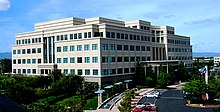


Thousands of high technology companies are headquartered in Silicon Valley. Among those, the following are in the Fortune 1000:
- Adobe Inc.
- AMD
- Agilent Technologies
- Alphabet Inc., includes Google
- Apple Inc.
- Applied Materials
- Block, Inc.
- Broadcom Inc.
- Cadence Design Systems
- Cisco Systems
- eBay
- Electronic Arts
- HP Inc.
- Intel
- Intuit
- Intuitive Surgical
- Juniper Networks
- KLA Corporation
- Lam Research
- Maxim Integrated
- Meta Platforms, includes Facebook
- NetApp
- Netflix
- Nvidia
- PayPal
- Salesforce
- Sanmina Corporation
- Seagate Technology
- ServiceNow
- Synnex
- Synopsys
- Western Digital
- X (Twitter)
Additional notable companies headquartered in Silicon Valley (some of which are defunct, subsumed, or relocated) include:
- 23andMe
- 3Com (acquired by Hewlett-Packard)
- 8x8
- Actel (acquired by Microsemi)
- Actuate Corporation
- Adaptec (acquired by PMC-Sierra)
- Aeria Games and Entertainment
- Altera (acquired by Intel)
- Amazon's A9.com
- Amazon's Lab126.com
- Amdahl (acquired by Fujitsu)
- Atari
- Atmel (acquired by Microchip Technology)
- Brocade Communications Systems (acquired by Broadcom)
- Be Inc. (acquired by Palm Inc.)
- BEA Systems (acquired by Oracle Corporation)
- Cypress Semiconductor (acquired by Infineon Technologies)
- Extreme Networks
- Fairchild Semiconductor (acquired by onsemi)
- Flex (formally Flextronics)
- Foundry Networks (acquired by Brocade Communications Systems)
- Geeknet (Slashdot)
- GlobalFoundries (moved to Malta, New York)
- GoPro
- Harmonic, Inc.
- Hitachi Data Systems
- Hitachi Global Storage Technologies (acquired by Western Digital)
- Hewlett Packard Enterprise (moved to Spring, Texas)
- IDEO
- Informatica
- LinkedIn (acquired by Microsoft)
- Lockheed Martin Space (now headquartered in Denver, Colorado)
- LSI (acquired by Broadcom)
- Maxtor (acquired by Seagate)
- McAfee (acquired by Intel)
- Memorex (acquired by Burroughs)
- Mozilla Foundation
- Move, Inc.
- National Semiconductor (acquired by Texas Instruments)
- Nook (subsidiary of Barnes & Noble)
- Oracle Corporation (moved to Austin, Texas)
- Palo Alto Networks
- Palm, Inc. (acquired by TCL Corporation)
- PARC
- Proofpoint
- Quantcast
- Quora
- Rambus
- Roku, Inc.
- RSA Security (acquired by EMC)
- SanDisk (acquired by Western Digital)
- SolarCity (acquired by Tesla, Inc.)
- Sony Mobile Communications (U.S. subsidiary headquarters)
- Sony Interactive Entertainment
- SRI International
- Sun Microsystems (acquired by Oracle Corporation)
- SunPower
- SurveyMonkey
- Symantec (now part of Gen Digital and headquartered in Tempe, Arizona)
- Syntex (acquired by Roche)
- Tesla, Inc. (now headquartered in Austin, Texas)
- TIBCO Software
- TiVo (acquired by Xperi)
- Uber
- Verifone (moved to Coral Springs, Florida)
- VeriSign (moved to Reston, Virginia)
- Veritas Technologies (split off from Symantec)
- VMware (acquired by Dell Technologies)
- Walmart Labs
- WebEx (acquired by Cisco Systems)
- YouTube (acquired by Google)
- Yelp, Inc.
- Zoom
- Zynga
- Xilinx (acquired by AMD)
Demographics
[edit]Silicon Valley has a population of 3.1 million as of 2020.[96] A 1999 study by AnnaLee Saxenian for the Public Policy Institute of California reported that a third of Silicon Valley scientists and engineers were immigrants and that nearly a quarter of Silicon Valley's high-technology firms since 1980 were run by Chinese (17 percent) or Indian descent CEOs (7 percent).[97] There is a stratum of well-compensated technical employees and managers, including tens of thousands of "single-digit millionaires". This income and range of assets will support a middle-class lifestyle in Silicon Valley.[98]
Gender
[edit]In November 2006, the University of California, Davis released a report analyzing business leadership by women within the state.[99] The report showed that although 103 of the 400 largest public companies headquartered in California were located in Santa Clara County (the most of all counties), only 8.8% of Silicon Valley companies had women CEOs.[100]: 4, 7 This was the lowest percentage in the state.[101] (San Francisco County had 19.2% and Marin County had 18.5%.)[100]
Silicon Valley tech leadership positions are occupied almost exclusively by men.[102] This is also represented in the number of new companies founded by women as well as the number of women-lead startups that receive venture capital funding. Wadhwa said he believes that a contributing factor is a lack of parental encouragement to study science and engineering.[103] He also cited a lack of women role models and noted that most famous tech leaders—like Bill Gates, Steve Jobs, and Mark Zuckerberg—are men.[102]
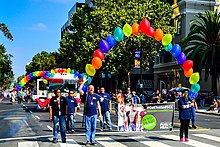
As of October 2014, some high-profile Silicon Valley firms were working actively to prepare and recruit women. Bloomberg reported that Apple, Facebook, Google, and Microsoft attended the 20th annual Grace Hopper Celebration of Women in Computing conference to actively recruit and potentially hire female engineers and technology experts.[104] The same month, the second annual Platform Summit was held to discuss increasing racial and gender diversity in tech.[105] As of April 2015 experienced women were engaged in creation of venture capital firms which leveraged women's perspectives in funding of startups.[106]
After UC Davis published its Study of California Women Business Leaders in November 2006,[100] some San Jose Mercury News readers dismissed the possibility that sexism contributed in making Silicon Valley's leadership gender gap the highest in the state. A January 2015 issue of Newsweek magazine featured an article detailing reports of sexism and misogyny in Silicon Valley.[107] The article's author, Nina Burleigh, asked, "Where were all these offended people when women like Heidi Roizen published accounts of having a venture capitalist stick her hand in his pants under a table while a deal was being discussed?"[108] Silicon Valley firms' board of directors are composed of 15.7% women compared with 20.9% in the S&P 100.[109]
The 2012 lawsuit Pao v. Kleiner Perkins was filed in San Francisco County Superior Court by executive Ellen Pao for gender discrimination against her employer, Kleiner Perkins.[110] The case went to trial in February 2015. On March 27, 2015, the jury found in favor of Kleiner Perkins on all counts.[111] Nevertheless, the case, which had wide press coverage, resulted in major advances in consciousness of gender discrimination on the part of venture capital and technology firms and their women employees.[112][113] Two other cases have been filed against Facebook and Twitter.[114]
Race
[edit]A 2017 study showed that white males made up the majority of higher positions, with 58.7% holding executive positions and 46.5% being managers. The second highest position holders were Asian men, with 16.3% having executive positions and 17.9% being managers. African/Black and Hispanic/Latino people had the lowest percentages in all categories.[115]
Harvard Business Review published an article in 2018 discussing diversity and inclusion and gave statistics on black employees along with advice to future black technicians. LeRon L. Barton, a black man who spent over two decades in Tech, gave an insight on his work experiences. He said he saw no one who looked like him in his profession and said he received many comments that he believed disregarded his skill such as being called the diversity hire. He described being isolated from his team, and constantly having to prove he could do the job he was hired for.[116]
Statistics
[edit]In 2014, tech companies Google, Yahoo!, Facebook, Apple, and others, released corporate transparency reports that offered detailed employee breakdowns. In May, Google said 17% of its tech employees worldwide were women, and, in the U.S., 1% of its tech workers were black and 2% were Hispanic/Latino.[117] June 2014 brought reports from Yahoo! and Facebook. Yahoo! said that 15% of its tech jobs were held by women, 2% of its tech employees were black and 4% Hispanic.[118] Facebook reported that 15% of its tech workforce was female, and 3% was Hispanic and 1% was black.[119]
In August 2014, Apple reported that 80% of its global tech staff was male and that, in the U.S., 54% of its tech jobs were staffed by Caucasians and 23% by Asians.[120] Soon after, USA Today published an article about Silicon Valley's lack of tech-industry diversity, pointing out that it is largely white or Asian, and male. "Blacks and Hispanics are largely absent," it reported, "and women are underrepresented in Silicon Valley—from giant companies to start-ups to venture capital firms."[121] Civil rights activist Jesse Jackson said of improving diversity in the tech industry, "This is the next step in the civil rights movement"[122] while T. J. Rodgers has argued against Jackson's assertions.
According to a 2019 Lincoln Network survey, 48% of high-tech workers in Silicon Valley identify as Christians, with Roman Catholicism (27%) being its largest branch, followed by Protestantism (19%).[123] The same study found that 16% of high-tech workers identify as nothing in particular, 11% as something else, 8% as Agnostics, and 7% as Atheists. Around 4% of high-tech workers in Silicon Valley identify as Jews or Buddhists, 3% as Hindus, 2% as Muslims and 1% as Satanists.[123]
Municipalities
[edit]The following Santa Clara County cities are traditionally considered to be in Silicon Valley (in alphabetical order):[124][125]
The geographical boundaries of Silicon Valley have changed over the years. Historically, the term Silicon Valley was treated as synonymous with Santa Clara Valley,[1][2][3] and then its meaning later evolved to refer to Santa Clara County plus adjacent regions in southern San Mateo County and southern Alameda County.[126] However, over the years this geographical area has been expanded to include San Francisco County, Contra Costa County, and the northern parts of Alameda County and San Mateo County, this shift has occurred due to the expansion in the local economy and the development of new technologies.[126]
The United States Department of Labor's Quarterly Census of Employment and Wages program defined Silicon Valley as the counties of Alameda, Contra Costa, San Francisco, San Mateo, Santa Clara, and Santa Cruz.[127] In 2015, MIT researchers developed a novel method for measuring which towns are home to startups with higher growth potential and this defines Silicon Valley to center on the municipalities of Menlo Park, Mountain View, Palo Alto, and Sunnyvale.[128][129]
Education
[edit]Colleges and universities
[edit]Silicon Valley is associated with many colleges and universities in and near the Valley. The most prominent of those institutions are Stanford University, a private university located in the Valley, and the University of California, Berkeley, a public university located north of Silicon Valley. Both are considered to be world-leading institutions.[130] More broadly, colleges and universities in the area include:
- Bay Area Medical Academy
- California University of Management and Technology
- California South Bay University
- Carnegie Mellon Silicon Valley
- Cañada College
- Chabot College
- De Anza College
- DeVry University
- Evergreen Valley College
- Foothill College
- Gavilan College
- Golden Gate University
- International Technological University
- Lincoln Law School of San Jose
- Menlo College
- Mission College
- National University San Jose Campus
- Northwestern Polytechnic University
- Ohlone College
- Palo Alto University
- Palmer College of Chiropractic, West Campus
- Peralta Colleges
- San Jose City College
- San José State University
- Santa Clara University
- Sofia University
- Stanford University
- University of California, Berkeley
- University of California, Santa Cruz, Silicon Valley Campus
- University of San Francisco South Bay Campus
- University of Silicon Valley
- West Valley College
- William Jessup University
Secondary Education
[edit]Funding for public schools in upscale Silicon Valley communities such as Woodside is often supplemented by grants from private foundations set up for that purpose and funded by local residents. Schools in less affluent areas such as East Palo Alto must depend on state funding.[131]
Culture
[edit]Events
[edit]- Apple Worldwide Developers Conference, San Jose
- Facebook F8, San Jose
- Silicon Valley Comic Con, San Jose
- Silicon Valley Pride, San Jose
Museums
[edit]- Computer History Museum
- Children's Discovery Museum of San Jose
- De Saisset Museum at Santa Clara University
- Hiller Aviation Museum
- History Park by History San José
- The HP Garage
- Intel Museum
- Los Altos History Museum
- Moffett Field Historical Society Museum
- Palo Alto Art Center
- Sunnyvale Heritage Park Museum
- The Tech Museum of Innovation
Media
[edit]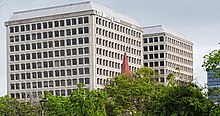
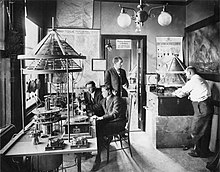
In 1980, Intelligent Machines Journal changed its name to InfoWorld, and, with offices in Palo Alto, began covering the emergence of the microcomputer industry in the valley.[133]
Local and national media cover Silicon Valley and its companies. CNN, The Wall Street Journal, and Bloomberg News operate Silicon Valley bureaus out of Palo Alto. Public broadcaster KQED (TV) and KQED-FM, as well as the Bay Area's local ABC station KGO-TV, operate bureaus in San Jose. KNTV, NBC's local Bay Area affiliate "NBC Bay Area", is located in San Jose. Produced from this location is the nationally distributed TV Show "Tech Now" as well as the CNBC Silicon Valley bureau. San Jose-based media serving Silicon Valley include the San Jose Mercury News daily and the Metro Silicon Valley weekly.
Specialty media include El Observador and the San Jose / Silicon Valley Business Journal. Most of the Bay Area's other major TV stations, newspapers, and media operate in San Francisco or Oakland. Patch.com operates various web portals, providing local news, discussion and events for residents of Silicon Valley. Mountain View has a public nonprofit station, KMVT-15. KMVT-15's shows include Silicon Valley Education News (EdNews)-Edward Tico Producer.
Cultural references
[edit]Some appearances in media, in order by release date:
- A View to a Kill—1985 film from the James Bond series. Bond thwarts an elaborate ploy by the film's antagonist, Max Zorin, to destroy Silicon Valley.[134]
- Triumph of the Nerds: The Rise of Accidental Empires – 1996 documentary
- Pirates of Silicon Valley—1999 film about the early days of Apple Computer and Microsoft (though the latter has never been based in Silicon Valley)
- Code Monkeys—2007 comedy series
- The Social Network—2010 film
- Startups Silicon Valley—reality TV series, debuted 2012 on Bravo[135]
- Betas—TV series, debuted 2013 on Amazon Video[136]
- Jobs—2013 film
- The Internship—2013 comedy film about working at Google
- Silicon Valley—2014 American sitcom from HBO
- Halt and Catch Fire—2014 TV series, the last two seasons are primarily set in Silicon Valley
- Steve Jobs—2015 film
- Watch Dogs 2—2016 video game developed by Ubisoft
- Valley of the Boom—2019 docudrama about the 1990s tech boom in Silicon Valley
- Devs—2020 TV miniseries
- Start-Up—2020 South Korean television series, when three artificial intelligence (A.I.) developers from South Korea are offered positions as engineers for the fictional company, 2STO which is located in Silicon Valley.
- The Dropout—2022 TV miniseries about the rise and fall of Theranos
- Super Pumped—2022 TV series about Travis Kalanick's time at Uber
See also
[edit]- Fail fast (business), an element of corporate culture common among Silicon Valley organizations[137]
- List of tourist attractions in Silicon Valley
- List of places with "Silicon" names around the world
- List of technology centers around the world
- Semiconductor industry
References
[edit]- ^ a b c d Malone, Michael S. (2002). The Valley of Heart's Delight: A Silicon Valley Notebook 1963 - 2001. New York: John S. Wiley & Sons. p. xix. ISBN 9780471201915. Retrieved July 28, 2020.
- ^ a b Matthews, Glenna (2003). Silicon Valley, Women, and the California Dream: Gender, Class, and Opportunity in the Twentieth Century. Stanford: Stanford University Press. p. 2. ISBN 9780804741545.
- ^ a b Shueh, Sam (2009). Silicon Valley. Charleston, SC: Arcadia Publishing. p. 8. ISBN 9780738570938. Retrieved July 28, 2020.
- ^ "San Jose no longer in Top 10 of most populous U.S. cities". The Mercury News. May 18, 2023. Retrieved May 20, 2023.
- ^ Hall, Gina (January 23, 2015). "Silicon Valley Business Journal – San Jose Area has World's Third-Highest GDP Per Capita, Brookings Says". Archived from the original on March 9, 2017. Retrieved April 3, 2018.
- ^ Kolomatsky, Michael (June 17, 2021). "Where Are the Million-Dollar Homes? - A new report reveals which U.S. metropolitan areas have the highest percentage of homes valued at $1 million or more". The New York Times. Archived from the original on December 28, 2021. Retrieved June 18, 2021.
- ^ Cara Eisenpress (April 28, 2023). "New York is closer than ever to beating the Bay Area on tech". Crain Communications. Retrieved October 14, 2023.
- ^ Cara Eisenpress (May 22, 2023). "For the first time, Manhattan edges out San Francisco in new early-stage startups". Crain Communications. Retrieved October 14, 2023.
- ^ "Silicon Valley Index 2022 report" (PDF). Silicon Valley Index. Archived (PDF) from the original on June 4, 2022. Retrieved May 24, 2022.
- ^ Carson, Biz. "16 Silicon Valley landmarks you must visit on your next trip". Business Insider. Archived from the original on July 25, 2019. Retrieved July 25, 2019.
- ^ "Tech Headquarters You Can Visit in Silicon Valley". TripSavvy. Archived from the original on July 25, 2019. Retrieved July 25, 2019.
- ^ Sheng, Ellen (December 3, 2018). "Why the headquarters of iconic tech companies are now among America's top tourist attractions". CNBC. Archived from the original on July 26, 2019. Retrieved July 26, 2019.
- ^ a b c Laws, David (January 7, 2015). "Who named Silicon Valley?". Computer History Museum. Archived from the original on October 16, 2018. Retrieved October 16, 2018.
- ^ "HLS, Incorporated". The Peninsula Times Tribune. May 25, 1970. p. 9. Retrieved September 3, 2024.
- ^ The Frivolous Valley and Its Dreadful Conformity, by Michael Anton (Law & Liberty, published September 4, 2018)
- ^ "Timeline of the history of water in Santa Clara County - Santa Clara Valley Water District". Valleywater.org. Archived from the original on February 8, 2010. Retrieved February 8, 2023.
- ^ Santa Clara Valley Groundwater Basin, East Bay Plain Subbasin Archived 2020-12-25 at the Wayback Machine
- ^ Valley of Heart's Delight : Free Download & Streaming : Internet Archive. Archive.org (March 10, 2001). Retrieved on 2013-07-21.
- ^ Golden Harvest...Fifty Years of Calpak Progress : California Packing Corporation, Industrial and Public Relations Department : Free Download & Streaming : Internet Archive. Archive.org. Retrieved on July 21, 2013.
- ^ https://valleyofheartsdelight.com/ Quote:
“The Valley of Heart’s Delight” was the way in which Santa Clara County, home to San Jose and now Silicon Valley, was once described. For those of us who grew up climbing trees in the orchards, and who grow a few fruit trees in their own yards, it still is the Valley of Heart’s Delight. This valley was once famous for wheat, later for grapevines, citrus, nuts, cherry trees, and fruits of all kinds. Hints of the valley’s past are everywhere to be found. - ^ Silicon Valley Turns Fifty, by David Laws, published on January 11, 2021
- ^ Adams, Stephen B. (October 2005). "Stanford and Silicon Valley: Lessons on Becoming a High-Tech Region". California Management Review. 48 (1): 29–51. doi:10.2307/41166326. ISSN 0008-1256. JSTOR 41166326. S2CID 154947640.
- ^ Castells, Manuel (2011). The Rise of the Network Society. John Wiley & Sons. p. 52. ISBN 978-1-4443-5631-1. Archived from the original on September 5, 2015. Retrieved March 25, 2015.
- ^ O'Mara (2019). pp. 81–82, 111, 159–160, 279.
- ^ a b Sturgeon, Timothy J. (2000). "How Silicon Valley Came to Be". In Kenney, Martin (ed.). Understanding Silicon Valley: The Anatomy of an Entrepreneurial Region. Stanford University. ISBN 978-0-8047-3734-0. Archived from the original on September 5, 2015. Retrieved March 24, 2015.
- ^ Black, Dave. "Moffett Field History". moffettfieldmuseum.org. Archived from the original on April 6, 2005. Retrieved April 19, 2015.
- ^ Madrigal, Alexis C. (January 15, 2020). "Silicon Valley Abandons the Culture That Made It the Envy of the World". The Atlantic. Archived from the original on January 15, 2020. Retrieved January 15, 2020.
- ^ a b Markoff, John (April 17, 2009). "Searching for Silicon Valley". The New York Times. Archived from the original on April 29, 2011. Retrieved April 17, 2009.
- ^ "Scholar examines links between Stanford, Silicon Valley". news.stanford.edu. Retrieved December 11, 2022.
- ^ Stephen B. Adams, "Regionalism in Stanford's Contribution to the Rise of Silicon Valley", Enterprise & Society 2003 4(3): 521–543
- ^ Frederick Terman - "When Terman returned to Stanford University in 1946 as dean of engineering, he applied his wartime reputation and experience to augmenting the university's income by encouraging research for the U.S. government [...].
- ^ Sandelin, John, The Story of the Stanford Industrial/Research Park, 2004 Archived June 9, 2007, at the Wayback Machine
- ^ "History of Computing Industrial Era 1984–1985". thocp.net. Archived from the original on April 28, 2015. Retrieved April 19, 2015.
- ^ "The Stanford Research Park: The Engine of Silicon Valley". PaloAltoHistory.com. Archived from the original on March 29, 2014. Retrieved March 29, 2014.
- ^ Leonhardt, David (April 6, 2008). "Holding On". The New York Times. Archived from the original on May 25, 2017. Retrieved December 7, 2014.
In 1955, the physicist William Shockley set up a semiconductor laboratory in Mountain View, partly to be near his mother in Palo Alto. …
- ^ Markoff, John (January 13, 2008). "Two Views of Innovation, Colliding in Washington". The New York Times. Archived from the original on January 1, 2016. Retrieved December 7, 2014.
The co-inventor of the transistor and the founder of the valley's first chip company, William Shockley, moved to Palo Alto, Calif., because his mother lived there. ...
- ^ Tajnai, Carolyn (May 1985). "Fred Terman, the Father of Silicon Valley". Stanford Computer Forum. Carolyn Terman. Archived from the original on December 11, 2014. Retrieved December 10, 2014.
- ^ "Silicon Valley's First Founder Was Its Worst | Backchannel". Wired. ISSN 1059-1028. Archived from the original on September 1, 2019. Retrieved January 8, 2020.
- ^ Goodheart, Adam (July 2, 2006). "10 Days That Changed History". The New York Times. Archived from the original on September 2, 2017.
- ^ McLaughlin, John; Weimers, Leigh; Winslow, Ward (2008). Silicon Valley: 110 Year Renaissance. Silicon Valley Historical Association. ISBN 978-0-9649217-4-0. Archived from the original on April 2, 2015.
- ^ "1964 – First Commercial MOS IC Introduced". Computer History Museum. Archived from the original on December 22, 2015. Retrieved July 31, 2019.
- ^ Intel's First Microprocessor—the Intel 4004, Intel Corp., November 1971, archived from the original on May 13, 2008, retrieved May 17, 2008
- ^ "1971: Microprocessor Integrates CPU Function onto a Single Chip". Computer History Museum. Archived from the original on October 30, 2019. Retrieved July 22, 2019.
- ^ Federico Faggin, The Making of the First Microprocessor, IEEE Solid-State Circuits Magazine, Winter 2009, IEEE Xplore
- ^ Intel (April 15, 1974). "From CPU to software, the 8080 Microcomputer is here". Electronic News. New York: Fairchild Publications. pp. 44–45. Electronic News was a weekly trade newspaper. The same advertisement appeared in the May 2, 1974, issue of Electronics magazine.
- ^ Licklider, J. C. R. (April 23, 1963). "Topics for Discussion at the Forthcoming Meeting, Memorandum For: Members and Affiliates of the Intergalactic Computer Network". Washington, D.C.: Advanced Research Projects Agency, via KurzweilAI.net. Archived from the original on January 23, 2013. Retrieved January 26, 2013.
- ^ Leiner, Barry M.; et al. (December 10, 2003). ""Origins of the Internet" in A Brief History of the Internet version 3.32". The Internet Society. Archived from the original on June 4, 2007. Retrieved November 3, 2007.
- ^ Garreau, Joel (2006). Radical Evolution: The Promise and Peril of Enhancing Our Minds, Our Bodies—and what it Means to be Human. Broadway. p. 22. ISBN 978-0-7679-1503-8. Archived from the original on January 1, 2016. Retrieved September 7, 2015.
- ^ a b "Defense Advanced Research Projects Agency (DARPA) (United States Government)". Encyclopædia Britannica. Archived from the original on January 11, 2014. Retrieved January 11, 2014.
- ^ Christophe Lécuyer, "What Do Universities Really Owe Industry? The Case of Solid State Electronics at Stanford," Minerva: a Review of Science, Learning & Policy 2005 43(1): 51–71
- ^ a b Scott, W. Richard; Lara, Bernardo; Biag, Manuelito; Ris, Ethan; Liang, Judy (2017). "The Regional Economy of the San Francisco Bay Area". In Scott, W. Richard; Kirst, Michael W. (eds.). Higher Education and Silicon Valley: Connected But Conflicted. Baltimore: Johns Hopkins University Press. p. 65. ISBN 9781421423081. Retrieved August 11, 2019.
- ^ A Legal Bridge Spanning 100 Years: From the Gold Mines of El Dorado to the "Golden" Startups of Silicon Valley Archived June 1, 2013, at the Wayback Machine by Gregory Gromov
- ^ Morris, Rhett (July 26, 2014). "The First Trillion-Dollar Startup". Tech Crunch. Archived from the original on February 22, 2019. Retrieved February 22, 2019.
- ^ a b Dean, John C. (2000). "Fueling the Revolution: Commercial Bank Financing". In Lee, Chong-Moon; Miller, William F.; Hancock, Marguerite Gong; Rowen, Henry S. (eds.). The Silicon Valley Edge: A Habitat for Innovation and Entrepreneurship. Stanford: Stanford University Press. pp. 314–324. ISBN 9780804740630. Retrieved December 3, 2023.
- ^ Adams, Stephen B.; Chambers, Dustin; Schultz, Michael (2018). "A moving target: The geographic evolution of Silicon Valley, 1953–1990". Business History. 60 (6): 859–883. doi:10.1080/00076791.2017.1346612. S2CID 157613638.
- ^ Friedman, Lawrence M. (2004). American Law in the Twentieth Century. New Haven: Yale University Press. p. 470. ISBN 9780300102994. Retrieved August 12, 2020.
- ^ a b Baker, Debra (May 2000). "Go West, Young Lawyer". ABA Journal. pp. 34–38, 97. Retrieved July 9, 2023.
- ^ Suchman, Mark C. (2000). "Chapter Four: Dealmakers and Counselors: Law Firms as Intermediaries in the Development of Silicon Valley". In Kenney, Martin (ed.). Understanding Silicon Valley: The Anatomy of an Entrepreneurial Region. Stanford: Stanford University Press. pp. 71–97. ISBN 9780804737340. Retrieved July 9, 2023.
- ^ Johnson, Craig W. (2000). "Advising the New Economy: The Role of Lawyers". In Lee, Chong-Moon; Miller, William F.; Hancock, Marguerite Gong; Rowen, Henry S. (eds.). The Silicon Valley Edge: A Habitat for Innovation and Entrepreneurship. Stanford: Stanford University Press. pp. 325–341. ISBN 9780804740630. Retrieved December 3, 2023.
- ^ "Wages". ABA Profile of the Legal Profession 2023. American Bar Association. Retrieved December 3, 2023.
- ^ "Homebrew And How The Apple Came To Be". atariarchives.org. Archived from the original on April 7, 2015. Retrieved April 19, 2015.
- ^ Markoff, John (2006) [2005]. What the Dormouse Said: How the Sixties Counterculture Shaped the Personal Computer Industry. Penguin Books. ISBN 978-0-14-303676-0. Archived from the original on September 5, 2015. Retrieved March 25, 2015.
- ^ Wozniak, Steve (2006). iWoz. W.W. Norton & Company. p. 150. ISBN 978-0-393-33043-4.
After my first meeting, I started designing the computer that would later be known as the Apple I. It was that inspiring.
- ^ Freiberger, Paul; Swaine, Michael (2000) [1984]. Fire in the Valley: The Making of the Personal Computer. McGraw-Hill. ISBN 978-0-07-135895-8.
- ^ Graphical User Interface (GUI) Archived October 1, 2002, at the Wayback Machine from apple-history.com
- ^ Waters, John K. (2002). John Chambers and the Cisco Way: Navigating Through Volatility. John Wiley & Sons. p. 28. ISBN 9780471273554.
- ^ W. Josephujjwal sarkar Campbell (January 2, 2015). "The Year of the Internet". 1995: The Year the Future Began. University of California Press. ISBN 978-0-520-27399-3.
- ^ Banks, Marcus (May 16, 2008). "Nonfiction review: 'Once You're Lucky'". San Francisco Chronicle.
- ^ Reed Albergotti, "The Most Inventive Towns in America", Archived December 3, 2017, at the Wayback Machine Wall Street Journal, July 22–23, 2006, P1.
- ^ Ibid.
- ^ "The Unicorn List". Fortune. January 22, 2015. Archived from the original on April 11, 2015. Retrieved April 6, 2015.
- ^ "Silicon Valley". Retrieved November 14, 2024.
- ^ "The Lessons of Silicon Valley: A World-Renowned Technology Hub | Perspectives on Innovation | CSIS". www.csis.org. Retrieved November 14, 2024.
- ^ Kelly, Jack. "Which Cities Are Seeing The Most Growth In Tech Headcount?". Forbes. Retrieved November 14, 2024.
- ^ "Cybercities 2008: An Overview of the High-Technology Industry in the Nation's Top 60 Cities". aeanet.org. Retrieved April 19, 2015.
- ^ "America's Greediest Cities". Forbes. December 3, 2007. Archived from the original on July 29, 2017.
- ^ Albanesius, Chloe (June 24, 2008). "AeA Study Reveals Where the Tech Jobs Are". PC Magazine. Archived from the original on January 12, 2018.
- ^ Pimentel, Benjamin. "Silicon Valley and N.Y. still top tech rankings". MarketWatch. Archived from the original on December 10, 2008. Retrieved April 19, 2015.
- ^ "SAN JOSE-SUNNYVALE-SANTA CLARA METROPOLITAN STATISTICAL AREA" (PDF). Archived (PDF) from the original on September 24, 2019.
- ^ "gbcprime". dts.gbcprime.com (in Korean). Retrieved November 12, 2024.
- ^ "Venture Capital Survey Silicon Valley Fourth Quarter 2011". Fenwick.com. Archived from the original on May 14, 2013. Retrieved July 8, 2013.
- ^ Florida, Richard (December 7, 2023). "Where US Tech Investment Is Growing the Most". Bloomberg. Retrieved December 10, 2023.
- ^ "Porsche lands in Silicon Valley to develop sportscars of the future". IBI. May 8, 2017. Archived from the original on May 13, 2017. Retrieved May 8, 2017.
Carmakers who have recently expanded to Silicon Valley include Volkswagen, Hyundai, General Motors, Ford, Honda, Toyota, BMW, Nissan and Mercedes-Benz.
- ^ Matthews, Glenda (November 20, 2002). Silicon Valley, Women, and the California Dream: Gender, Class, and Opportunity in the Twentieth Century (1 ed.). Stanford, California: Stanford University Press. pp. 154–56. ISBN 978-0-8047-4796-7. Archived from the original on October 27, 2019. Retrieved January 16, 2015.
- ^ "Occupational Employment Statistics Semiconductor and Other Electronic Component Manufacturing". bls.gov. Bureau of Labor Statistics. May 2014. Archived from the original on May 5, 2015. Retrieved April 25, 2015.
- ^ a b Brown, Eliot (June 7, 2016). "Neighbors Clash in Silicon Valley Job growth far outstrips housing, creating an imbalance; San Jose chafes at Santa Clara". The Wall Street Journal. Archived from the original on June 7, 2016. Retrieved June 7, 2016.
- ^ Matthews, Glenda (November 20, 2002). Silicon Valley, Women, and the California Dream: Gender, Class, and Opportunity in the Twentieth Century (1 ed.). Stanford, California: Stanford University Press. pp. 233. ISBN 978-0-8047-4796-7. Archived from the original on October 27, 2019. Retrieved January 16, 2015.
- ^ "Zero down on a $2 million house is no problem in Silicon Valley's 'weird and scary' real estate market | Financial Post". Financial Post. July 29, 2016. Archived from the original on May 25, 2017. Retrieved October 14, 2017.
- ^ Potts, Monica (December 13, 2015). "Dispossessed in the Land of Dreams: Those left behind by Silicon Valley's technology boom struggle to stay in the place they call home". The New Republic. Archived from the original on December 14, 2015. Retrieved December 14, 2015.
A 2013 census showed Santa Clara County having more than 7,000 homeless people, the fifth-highest homeless population per capita in the country and among the highest populations sleeping outside or in unsuitable shelters like vehicles.
- ^ "Silicon Valley is changing, and its lead over other tech hubs narrowing". The Economist. Retrieved September 5, 2018.
- ^ "Why startups are leaving Silicon Valley". The Economist. Retrieved September 7, 2018.
- ^ a b Lazo, Alejandro (February 17, 2023). "Silicon Valley's vast wealth disparity deepens as poverty increased". CalMatters. Retrieved December 3, 2023.
- ^ Echeverria, Danielle (June 23, 2023). "$104K a year is 'low-income' for single people in 3 Bay Area counties, according to state data". San Francisco Chronicle. Retrieved December 3, 2023.
- ^ Kirkeby, Megan (June 6, 2023). "2023 State Income Limits" (PDF). California Department of Housing and Community Development. State of California. Retrieved December 3, 2023.
- ^ Olya, Gabrielle (December 2, 2023). "This Income Is Considered Poverty Level in 2023". Yahoo! Finance. Retrieved December 3, 2023.
- ^ "평균 연봉 1억7000·중국인이 주류…실리콘밸리의 모든 것 [김재후의 실리콘밸리101]". 한국경제 (in Korean). March 24, 2021. Retrieved November 12, 2024.
- ^ Saxenian, AnnaLee (1999). "Silicon Valley's New Immigrant Entrepreneurs" (PDF). Public Policy Institute of California. Archived (PDF) from the original on January 31, 2016.
{{cite journal}}: Cite journal requires|journal=(help) - ^ Riflin, Gary (August 5, 2007). "In Silicon Valley, Millionaires Who Don't Feel Rich". The New York Times. Archived from the original on June 5, 2015. Retrieved June 27, 2015.
Silicon Valley is thick with those who might be called working-class millionaires
- ^ "Women Missing From Decision-Making Roles in State Biz" (Press release). UC Regents. November 16, 2006. Archived from the original on April 2, 2015. Retrieved March 25, 2015.
- ^ a b c Ellis, Katrina (2006). "UC Davis Study of California Women Business Leaders" (PDF). UC Regents. Archived (PDF) from the original on April 2, 2015. Retrieved March 25, 2015.
{{cite journal}}: Cite journal requires|journal=(help) - ^ Zee, Samantha (November 16, 2006). "California, Silicon Valley Firms Lack Female Leaders (Update1)". Bloomberg L.P. Archived from the original on April 2, 2015. Retrieved March 25, 2015.
- ^ a b Wadhwa, Vivek (November 9, 2011). "Silicon Valley women are on the rise, but have far to go". Washington Post. Archived from the original on October 25, 2014. Retrieved December 26, 2014.
This is one of Silicon Valley's most glaring faults: It is male-dominated.
- ^ Wadhwa, Vivek (May 15, 2010). "Fixing Societal Problems: It Starts With Mom and Dad". TechCrunch. AOL. Archived from the original on December 27, 2014. Retrieved December 26, 2014.
- ^ Burrows, Peter (October 8, 2014). "Gender Gap Draws Thousands From Google, Apple to Phoenix". Bloomberg Business. Bloomberg. Archived from the original on April 2, 2015. Retrieved March 24, 2015.
- ^ Porter, Jane (October 29, 2014). "Inside the Movement That's Trying to Solve Silicon Valley's Diversity Problem". Fast Company. Mansueto Ventures. Archived from the original on March 19, 2015. Retrieved March 24, 2015.
- ^ Claire Cain Miller (April 1, 2015). "Female-Run Venture Capital Funds Alter the Status Quo" (Dealbook blog). The New York Times. Archived from the original on April 1, 2015. Retrieved April 2, 2015.
We're in the middle of a shifting trend where there are newly wealthy women putting their money to work, and similarly we're starting to have a larger number of experienced investors,
- ^ Burleigh, Nina (January 28, 2015). "What Silicon Valley Thinks of Women". Newsweek. Archived from the original on March 21, 2015. Retrieved March 21, 2015.
- ^ Tam, Ruth (January 30, 2015). "Artist behind Newsweek cover: it's not sexist, it depicts the ugliness of sexism". PBS NewsHour. Archived from the original on March 21, 2015. Retrieved March 21, 2015.
- ^ "Ellen Pao gender discrimination trial grips Silicon Valley". TheGuardian.com. March 13, 2015. Archived from the original on June 17, 2016. Retrieved June 6, 2016.
- ^ "Complaint of Ellen Pao" (PDF). Archived from the original (PDF) on March 3, 2016.
- ^ Liz Gannes and Nellie Bowles (March 27, 2015). "Live: Ellen Pao Loses on All Claims in Historic Gender Discrimination Lawsuit Against Kleiner Perkins". Re/code. Archived from the original on March 27, 2015. Retrieved March 27, 2015.
That's the full verdict. No on all claims.
- ^ Decker, Sue (March 26, 2015). "A Fish Is the Last to Discover Water: Impressions From the Ellen Pao Trial". Re/code. Archived from the original on March 27, 2015. Retrieved March 28, 2015.
We may look back at this as a watershed moment—regardless of how the very attentive jury comes out on their verdict.
- ^ Manjoo, Farhad (March 27, 2015). "Ellen Pao Disrupts How Silicon Valley Does Business". The New York Times. Archived from the original on March 28, 2015. Retrieved March 28, 2015.
Ms. Klein argued that the Kleiner trial would become a landmark case for women in the workplace, as consequential for corporate gender relations as Anita Hill's accusations in 1991 of sexual harassment during the confirmation hearings of Supreme Court Justice Clarence Thomas
- ^ Streitfeld, David (March 27, 2015). "Ellen Pao Loses Silicon Valley Gender Bias Case Against Kleiner Perkins". The New York Times. Archived from the original on March 31, 2015. Retrieved April 1, 2015.
In a sign that the struggle over the place of women in Silicon Valley is only beginning, gender discrimination suits have recently been filed against two prominent companies, Facebook and Twitter.
- ^ Rangarajan, Sinduja (June 25, 2018). "Bay Area tech diversity: White men dominate Silicon Valley". Reveal. Retrieved December 6, 2023.
- ^ Barton, LeRon L. (March 4, 2021). "What It's Like to Be a Black Man in Tech". Harvard Business Review. ISSN 0017-8012. Retrieved December 6, 2023.
- ^ Musil, Steven (May 28, 2014). "Google discloses its diversity record and admits it's not good". CNET. CBS Interactive. Archived from the original on March 4, 2016.
- ^ Levy, Karyne (June 17, 2014). "Yahoo's Diversity Numbers Are Just As Terrible As The Rest of the Tech Industry's". Business Insider. Archived from the original on April 2, 2015. Retrieved March 24, 2015.
- ^ Williams, Maxine (June 25, 2014). "Building a More Diverse Facebook". Facebook. Archived from the original on March 23, 2015. Retrieved March 24, 2015.
- ^ "Apple diversity report released; Cook 'not satisfied with the numbers'". CBS Interactive. Associated Press. August 13, 2014. Archived from the original on January 26, 2016.
- ^ Guynn, Jessica; Weise, Elizabeth (August 15, 2014). "Lack of diversity could undercut Silicon Valley". USA Today. Archived from the original on April 17, 2015. Retrieved March 24, 2015.
- ^ Koch, Wendy (August 15, 2014). "Jesse Jackson: Tech diversity is next civil rights step". USA Today. Archived from the original on March 3, 2015. Retrieved March 24, 2015.
- ^ a b "2019 Viewpoint Inclusion Survey Report" (PDF). Lincoln Network survey. February 22, 2009. p. 4. Archived from the original (PDF) on March 29, 2023. Retrieved February 23, 2023.
- ^ "We are Silicon Valley". Silicon Valley Central Chamber. Retrieved December 22, 2022.
- ^ "Explore Silicon Valley Cities". Visit Silicon Valley, California. Retrieved December 22, 2022.
- ^ a b O'Brien, Chris (April 19, 2012). "Welcome to the new and expanded Silicon Valley". The Mercury News. Archived from the original on April 10, 2018. Retrieved April 10, 2018.
After years of drawing a sharp circle that included Santa Clara County as well as southern San Mateo and Alameda counties, this newspaper is expanding the geographic boundaries that it considers to be part of Silicon Valley to include the five core Bay Area counties: Santa Clara, San Mateo, San Francisco, Alameda and Contra Costa.
- ^ "High-tech employment in Silicon Valley, 2001 and 2008". U.S. Bureau of Labor Statistics. September 8, 2009. Archived from the original on April 10, 2018. Retrieved April 10, 2018.
In this analysis, Silicon Valley is defined as Alameda, Contra Costa, San Francisco, San Mateo, Santa Clara, and Santa Cruz counties, in California.
- ^ Guzman, Jorge; Stern, Scott (September 2014). "Nowcasting and Placecasting Growth Entrepreneurship" (PDF). MIT Industrial Liaison Program. MIT. Archived from the original (PDF) on March 4, 2016. Retrieved December 21, 2022.
- ^ Guzman, Jorge; Stern, Scott (February 6, 2015). "Where is Silicon Valley?". Science. 347 (6222): 606–609. Bibcode:2015Sci...347..606G. doi:10.1126/science.aaa0201. ISSN 0036-8075. PMID 25657229. S2CID 206632492.
- ^ "Stanford at #3 in 2024 best college rankings from US News; UC Berkeley top public school - CBS San Francisco". www.cbsnews.com. September 18, 2023. Retrieved March 2, 2024.
- ^ Packer, George (May 27, 2013). "Change the World Silicon Valley transfers its slogans—and its money—to the realm of politics". The New Yorker. Archived from the original on July 29, 2015. Retrieved July 30, 2015.
In wealthy districts, the public schools have essentially been privatized; they insulate themselves from shortfalls in state funding with money raised by foundations they have set up for themselves.
- ^ "Bay Area Radio Museum - The Charles Herrold Story". August 12, 2014.
- ^ Markoff, John (September 1999). Foreword, Fire in the Valley (Updated ed.). McGraw-Hill. pp. xi–xiii. ISBN 978-0-07-135892-7.
- ^ "A View to a Kill (1985) - Plot". IMDb. Archived from the original on October 27, 2019. Retrieved April 2, 2019.
- ^ "Start-Ups:Silicon Valley". IMDb. November 5, 2012. Archived from the original on March 24, 2016. Retrieved March 30, 2016.
- ^ "Betas". IMDb. April 19, 2013. Archived from the original on April 3, 2016. Retrieved March 30, 2016.
- ^ Surowiecki, James (May 12, 2014). "Epic Fails of the Startup World". The New Yorker. ISSN 0028-792X. Retrieved November 3, 2023.
Further reading
[edit]Books
[edit]- Bronson, Po (2013). The Nudist on the Lateshift: and Other Tales of Silicon Valley. Random House. ISBN 978-1-4481-8964-9.
- Cringely, Robert X. (1996) [1992]. Accidental Empires: How the boys of Silicon Valley make their millions, battle foreign competition, and still can't get a date. HarperCollins. ISBN 978-0-88730-855-0.
- Halpin, Darren R., and Anthony J. Nownes. The New Entrepreneurial Advocacy: Silicon Valley Elites in American Politics (Oxford University Press, USA, 2021).
- English-Lueck, June Anne (2002). Cultures@Silicon Valley. Stanford University Press. ISBN 978-0-8047-4429-4.
- Hayes, Dennis (1990) [1989]. Behind the Silicon Curtain: The Seductions of Work in a Lonely Era. Black Rose Books. ISBN 978-0-921689-62-1.
- Kaplan, David A. (2000). The Silicon Boys: And Their Valleys Of Dreams. HarperCollins. ISBN 978-0-688-17906-9.
- Koepp, Rob (April 11, 2003). Clusters of Creativity: Enduring Lessons on Innovation and Entrepreneurship from Silicon Valley and Europe's Silicon Fen. John Wiley & Sons. ISBN 978-0-470-85566-9.
- Lécuyer, Christophe Lécuyer (2006) [2005]. Making Silicon Valley: Innovation and the Growth of High Tech, 1930–1970. Chemical Heritage Foundation. ISBN 978-0-262-12281-8.
- Levy, Steven (2014) [1984]. Hackers: Heroes of the Computer Revolution. O'Reilly Media. ISBN 978-1-4493-8839-3.
- O'Mara, Margaret. The Code: Silicon Valley and the Remaking of America (2019).
- O'Mara, Margaret Pugh (2015) [2004]. Cities of Knowledge: Cold War Science and the Search for the Next Silicon Valley. Princeton University Press. ISBN 978-1-4008-6688-5.
- Pellow, David N; Park, Lisa Sun-Hee (2002). The Silicon Valley of Dreams: Environmental Injustice, Immigrant Workers, and the High-tech Global Economy. New York University Press. ISBN 978-0-8147-6710-8.
- Saxenian, AnnaLee (1996). Regional Advantage: Culture and Competition in Silicon Valley and Route 128. Harvard University Press. ISBN 978-0-674-75340-2.
- Scoville, Thomas (2001). Silicon Follies (Fiction). Simon & Schuster. ISBN 978-0-7434-1945-1.
- Whiteley, Carol; McLaughlin, John (2002). Technology, Entrepreneurs and Silicon Valley. Silicon Valley Historical Association. ISBN 978-0-9649217-1-9. Archived from the original on December 4, 2019. Retrieved March 25, 2015.
Journals and newspapers
[edit]- Alexandre, Olivier. "Culture as a universal variable opportunity flow and selection process in Silicon Valley." Glocalism: Journal of Culture, Politics and Innovation (2022). online
- Kantor, Jodi (December 23, 2014). "A Brand New World in Which Men Ruled". The New York Times.
- Koenig, Neil (February 9, 2014). "Next Silicon Valleys: How did California get it so right?". BBC News.
- Kwon, Doris, and Olav Sorenson. "The Silicon Valley Syndrome." Entrepreneurship Theory and Practice (2021): online
- Malone, Michael S. (January 30, 2015). "The Purpose of Silicon Valley". MIT Technology Review.
- Norr, Henry (December 27, 1999). "Growth of a Silicon Empire". San Francisco Chronicle.
- Palmer, Barbara (February 4, 2004). "Red tile roofs in Bangalore: Stanford's look copied in Silicon Valley and beyond". Stanford Report.
- Schulz, Thomas (March 4, 2015). "Tomorrowland: How Silicon Valley Shapes Our Future". Der Spiegel.
- Sturgeon, Timothy J. (December 2000). "Chapter Two: How Silicon Valley Came to Be" (PDF). Industrial Performance Center. Massachusetts Institute of Technology. Archived from the original (PDF) on August 19, 2018. Retrieved March 24, 2015.
- Williams, James C. (December 2013). "From White Gold to Silicon Chips: Hydraulic Technology, Electric Power and Silicon Valley". Social Science Information (Abstract). 52 (4). SAGE Publications: 558–574. doi:10.1177/0539018413497834. S2CID 145080600. (Subscription required for full text.)
Audiovisual
[edit]- Silicon Valley: A Five Part Series (DVD). Narrated by Leonard Nimoy. Silicon Valley Historical Association. 2012.
{{cite AV media}}: CS1 maint: others in cite AV media (notes) (link) - Staff (August 27, 2010). "A Weekend in Silicon Valley". The New York Times (Slideshow).
External links
[edit]- Santa Clara County: California's Historic Silicon Valley—A National Park Service website
- Silicon Valley—An American Experience documentary broadcast in 2013
- Silicon Valley Cultures Project at the Wayback Machine (archived December 20, 2007) from San Jose State University
- Silicon Valley Historical Association
- Silicon Valley Central Chamber of Commerce website




